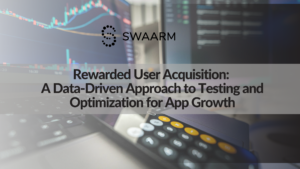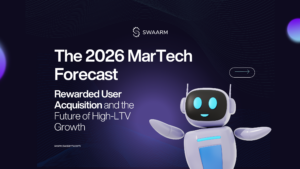Introduction
Ibrahim Mert‘s journey in digital marketing and growth strategy showcases a wealth of experience gathered across five different start-ups.
A particularly noteworthy chapter was his involvement with an online video shopping platform in Türkiye, which aimed to enhance the shopping experience by enabling users to purchase products directly from live video streams on iOS and Android devices. This concept, now seen in platforms like TikTok’s collaboration with Amazon, was ahead of its time.
In this role, the team was tasked with more than just driving app installs; they needed to ensure that users remained engaged during live shopping events. The challenge lay in attracting a substantial audience during live broadcasts and managing real-time user engagement—a complex task that required a collaborative strategy. Despite efforts involving various digital marketing approaches, including Google, Meta, and TikTok ads, as well as affiliate marketing, the team encountered significant challenges, particularly during prime-time live shows.
One campaign, in partnership with a popular tech news website in Türkiye, successfully drove a large number of users to the platform through a native ad campaign. However, this success brought unexpected difficulties when the app’s infrastructure struggled to support over 3,000 users during a live event, leading to a crash. This incident, while challenging, provided valuable lessons about the importance of balancing marketing efforts with robust product infrastructure.
Following his experiences with start-ups, Ibrahim has continued to hone his expertise in growth marketing. He has shared his knowledge as a mentor at İTÜ Çekirdek, Startgate, and Bilişim Vadisi in Azerbaijan, offering guidance on scaling businesses and managing digital projects. His extensive experience has given him a deep understanding of the role of tools like Mobile Measurement Partners (MMPs) in optimizing app performance.
Now, as part of the team at 4play, Ibrahim continues to apply his experience to new challenges, contributing to innovative approaches that drive growth in the ever-changing digital landscape.
Question 1: Can you tell us more about your journey, starting from your early experiences to your current role at 4play? How has your career evolved, especially with your involvement in mentoring startups?
My journey into growth marketing has been quite dynamic, beginning in Wunderman Istanbul with a strong foundation in ATL and BTL marketing and evolving through various hands-on experiences in different industries. Early in my career, I focused heavily on understanding the digital landscape and how to leverage data to drive growth. This interest naturally led me to specialize in growth marketing, where I could use my skills to scale businesses, particularly in the highly competitive mobile app sector.
One of the pivotal moments in my career was my involvement with startups, where I had the opportunity to mentor and guide emerging companies, particularly in İTÜ Çekirdek, Startgate and Bilişim Vadisi. Working closely with these startups, I gained invaluable insights into the challenges they face, from limited resources to the need for rapid iteration. This experience taught me the importance of being agile and innovative, especially in fast-paced environments.
This experience reinforced the critical role that user experience plays in the success of digital products, especially in innovative fields like live shopping, fintech, health, SaaS in the B2B and gaming sector.
In my current role at 4play, I apply these lessons daily. My focus is on identifying growth opportunities and adapting strategies to fit the unique needs of our platform. One of the key areas of focus is user acquisition, which is fundamentally about attracting the right users to your app—those who are likely to find value in it and engage with it over time. User acquisition is crucial when developing and promoting an app because it’s the first step in building a user base. Without a strong acquisition strategy, even the most well-designed app can struggle to gain traction. Effective user acquisition involves understanding your target audience, optimizing your app’s visibility through App Store Optimization (ASO), and leveraging both paid and organic marketing channels to reach potential users.
In this industry, some of the most important Key Performance Indicators (KPIs) include Customer Acquisition Cost (CAC), which measures how much it costs to acquire a new user, and Lifetime Value (LTV), which estimates the total revenue that a user will generate over their lifetime. Other crucial KPIs include Retention Rate, which shows how well the app keeps users engaged over time, and Churn Rate, which indicates the percentage of users who stop using the app after a certain period. These metrics are essential for evaluating the effectiveness of user acquisition strategies and ensuring long-term success.
At 4play, we’re constantly optimizing our approach to user acquisition, using data-driven insights to refine our strategies and ensure that we’re attracting and retaining high-quality users. This focus on continuous improvement and adaptation is key to staying competitive in the ever-evolving mobile app landscape.
Question 2: You’ve mentioned working with different Mobile Measurement Partners (MMPs). What challenges have you faced, and what improvements do you think are necessary for these tools?
One of the key challenges with Mobile Measurement Partners (MMPs) is the steep learning curve, especially for new users. Often, the individuals who use these tools daily—such as marketing interns, product managers, or junior marketers—are not the ones involved in the purchasing decision, which can lead to a gap in understanding how to fully leverage the tool’s features. This can result in underutilization of the MMP’s capabilities and a slower onboarding process.
I believe MMPs could improve by offering more comprehensive post-purchase education and support, ensuring that all users, regardless of their technical expertise, can navigate and utilize the dashboard effectively. This might include more intuitive, user-friendly interfaces and enhanced training resources tailored to different user roles within a company.
Another critical area for improvement is real-time data accuracy. In the fast-paced world of mobile apps, especially during high-stakes events like live shopping, payment, user acquisition, signup experiences I experienced at startups, any delay in data reporting can have significant consequences. Real-time insights are crucial for making quick, informed decisions, whether it’s optimizing ad campaigns on the fly or adjusting user engagement strategies during a live event.
Fraud prevention is also a growing concern that MMPs need to address more robustly. As digital advertising becomes more sophisticated, so do the methods used by fraudsters. MMPs must stay ahead of these tactics by implementing advanced fraud detection and prevention measures to ensure that the data marketers rely on is clean and reliable.
My first encounter with Swaarm was during my role as Chief Growth Officer at StartGate, where we implemented their MMP as an official attribution partner for all the projects rising from their programs. I’ve noticed that platforms like Swaarm are making strides in addressing some of these challenges. Swaarm, for example, is known for its focus on providing real-time, accurate data, which is essential for optimizing campaigns effectively and preventing fraud. Their approach to making data actionable and easy to interpret is a step in the right direction for the industry. If more MMPs could adopt this level of real-time data responsiveness and user-centric design, it would significantly enhance the effectiveness of mobile marketing efforts and provide teams with the tools they need to succeed in a competitive landscape.
In summary, while MMPs are invaluable tools for tracking and optimizing mobile app performance, there’s still room for improvement in terms of user accessibility, real-time data accuracy, and fraud prevention. By addressing these areas, MMPs can better support marketers in achieving their goals and driving sustained growth.
Question 3: You talked about the importance of deeplinking in mobile applications. Can you elaborate on why it’s so critical and how it impacts app success?
Deeplinking is something I see as absolutely essential for a smooth and effective user experience in mobile apps. At its core, deeplinking means using URLs that take users directly to specific content or pages within an app, rather than just sending them to the app’s homepage. This might sound straightforward, but it can make a huge difference in how users interact with your app.
From my perspective, deep linking really shines when it comes to user experience. If a user clicks on an ad for a particular product, they should be taken straight to that product page within the app. If they’re instead dumped on the homepage and have to dig through several layers to find what they’re looking for, it can be frustrating. This frustration can lead to users abandoning the app, which is something every app developer wants to avoid. In my experience, deep linking can directly influence conversion rates. When users are directed exactly where they want to go, they’re more likely to complete their intended actions, whether that’s making a purchase or signing up for a service. For example, if someone receives a promotional email about a special discount and clicks on it, they should land right on the discount page in the app. This direct approach makes the whole process smoother and more efficient.
I also think deep linking contributes to better marketing effectiveness. It allows campaigns to be more targeted and precise. If you’re running a campaign and using deep links, you can accurately track how many users clicked through and what actions they took. This kind of insight is invaluable for understanding what’s working and what needs adjustment.
Lastly, deep linking plays a role in user retention. By making navigation easy and intuitive, you help users have a more positive experience, which encourages them to return to the app. If users find what they need quickly and efficiently, they’re more likely to stay engaged over the long term. In short, deeplinking is crucial because it helps to provide a seamless and engaging experience for users. It’s not just about making things easier; it’s about creating an experience that users appreciate and want to return to.
Question 4: What are some overlooked aspects of mobile app marketing that startups should be aware of, especially when using tools like MMPs?
Startups often get caught up in the excitement of acquiring new users and focus heavily on driving app installs. However, they frequently overlook several critical aspects of mobile app marketing that can make or break their success.
One key area that’s often underestimated is user retention and loyalty. It’s not enough to simply get users to download your app; you need to ensure that they stay engaged and continue using it over time. This involves understanding the full customer journey and creating strategies that keep users coming back. For instance, monitoring uninstall rates can provide valuable insights into why users might be leaving your app and where improvements can be made.
Another crucial yet often overlooked aspect is the onboarding process with an MMP. A well-designed onboarding experience is not just about understanding the platform itself but also about enabling users to navigate the entire MMP ecosystem effectively. This process is vital for ensuring that users can quickly dive into the analytics and monitor key performance indicators (KPIs) such as retention, return on ad spend (ROAS), and more.
During our discussion, we explored how Swaarm addresses these challenges through its comprehensive onboarding approach. Swaarm goes beyond simply offering a tool; they provide a tailored onboarding experience that equips clients with the skills to fully navigate the MMP ecosystem. This hands-on support ensures that clients can quickly understand how to monitor and analyze crucial KPIs, make informed campaign adjustments, and identify key app features—all of which are essential for retaining users and optimizing marketing efforts.
In summary, while driving installs is essential, startups must also focus on user retention, understanding the customer journey, and leveraging a robust onboarding process. Tools like Swaarm play a pivotal role by providing the necessary guidance and support, allowing startups to efficiently manage and optimize their marketing campaigns, ultimately driving sustained growth and success.
Question 5: How can MMPs better support startups in optimizing their onboarding processes and overall user experience?
In my view, MMPs (Mobile Measurement Partners) have a significant role to play in supporting startups with their onboarding processes and overall user experience. To be more effective, MMPs could expand their offerings beyond just basic analytics and attribution.
One way to improve is by developing more sophisticated tools and features specifically designed to optimize onboarding. For instance, customizable onboarding templates could help startups create a seamless introduction to their apps, tailored to their unique needs. Additionally, incorporating advanced analytics that track user interactions during the onboarding process can provide valuable insights into where users are dropping off or experiencing difficulties. These insights can be crucial for identifying pain points and refining the onboarding flow to enhance user retention.
One way to improve the effectiveness of MMPs is by developing more sophisticated tools and features specifically designed to optimize the onboarding process. For instance, customizable onboarding templates could enable startups to create a seamless and personalized introduction to the MMPs, tailored to their specific needs. Additionally, incorporating analytics that track user interactions within the onboarding process can offer valuable insights into how users from the startups engage with the MMP ecosystem, including where they might drop off or encounter difficulties. These insights are crucial for identifying pain points, allowing businesses to refine the onboarding flow. By optimizing this initial experience, MMP can help startups to better position themselves to quickly adapt to changes, spot trends, and ultimately enhance user retention.
Moreover, MMPs should offer actionable recommendations based on these insights. This means going beyond data collection to provide practical advice on how startups can address the issues identified. For example, if analytics reveal that users are struggling with a particular feature during onboarding, the MMP could suggest targeted adjustments or improvements. It’s also essential for MMPs to focus on the entire user journey, not just the initial install. Providing tools that track and analyze user engagement and behavior over time can help startups understand how their onboarding efforts are influencing long-term user retention and satisfaction.
Ultimately, MMPs should aim to be more than just measurement tools; they should act as partners in helping startups create a better user experience. By offering comprehensive support, including in-depth onboarding analytics, customizable solutions, and actionable insights, MMPs can greatly contribute to a startup’s success and help ensure that new users not only start strong but continue to engage with the app in a meaningful way.
Conclusion
In this insightful conversation with Ibrahim Mert, we’ve delved into the intricacies of growth marketing in the mobile app industry, reflecting on his journey from mentoring startups to leading growth at 4play. Currently, as the Head of Growth at 4play, Ibrahim plays a pivotal role in driving the company’s innovative approach to mobile marketing. 4play specializes in creating engaging mobile experiences that reward users for their online activities. This is not just about typical marketing—it’s about transforming how brands connect with their audiences through gamification and incentives.
One of 4play’s flagship products is the app “Kim GB İster” (Who Wants GB), which is a prime example of how Ibrahim’s expertise in user experience and growth marketing is put into action. The app gamifies the process of earning mobile data in Turkiye, offering users a chance to win data packages by playing games. This approach not only attracts a wide user base but also keeps them engaged, reflecting Ibrahim’s deep understanding of user retention and engagement strategies.
4play has been focusing on enhancing these interactive experiences, ensuring that they are seamless and engaging, thereby fostering strong customer loyalty. The app’s success is a testament to the effective use of deep linking and real-time data analytics—areas that Ibrahim emphasized during our discussion. These tools are critical in guiding users through the app in a way that feels intuitive and rewarding, ultimately driving higher conversion rates and sustained user growth.
Moreover, 4play’s innovative model aligns perfectly with Ibrahim’s philosophy that mobile marketing should not only acquire users but also keep them engaged and coming back. By combining gamification with real-time user insights, 4play is setting new standards in mobile marketing, offering brands a unique way to connect with their audiences while providing users with tangible rewards.
For startups and mobile app developers, Ibrahim’s work at 4play serves as an inspiring example of how to leverage technology, user behavior insights, and creative engagement strategies to build and sustain a successful mobile app. His approach underscores the importance of not just reaching users but creating meaningful, enjoyable experiences that encourage long-term loyalty—a strategy that is proving to be highly effective in today’s competitive mobile landscape.



